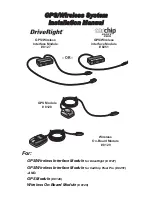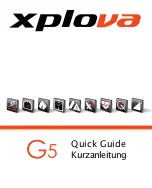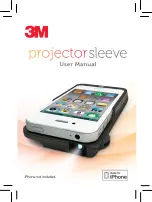
Wireless Light Sensor
The Wireless Light Sensor measures four quantities:
Illuminance, Ultraviolet Index, Solar Irradiance, and Solar PAR.
• Illuminance is a measure of the amount of light that
reaches a surface. It is reported in lux (lx), also called
lumens per square meter.
• The Ultraviolet Index, or UV Index, is a linear scale
measurement proportional to the amount of ultraviolet
radiation the sensor detects; this value indicates the time it
takes for harm to occur due to ultraviolet radiation in the
vicinity of the sensor. The UV Index does not include a unit.
• Solar Irradiance refers to the amount of power the sun’s
light delivers to a given area. Solar irradiance can be
reported in W/m
2
(watts per square meter), mW/m
2
, µW/m
2
,
or µW/cm
2
.
• Solar PAR (Photosynthetically Active Radiation)
measures the number of photons within the range of
wavelengths conducive to photosynthesis which fall on a
given surface area per second. Solar PAR can be reported
in µmol/m
2
/s (micromoles per square meter per second) or
mol/m
2
/s.
For greatest accuracy when using the Wireless Light Sensor,
ensure that the white disk on top of the sensor is clean and dry.
Wireless Compass
The Wireless Compass measures Magnetic Heading and
reports it in either degrees (°) or radians (rad). In addition, the
Wireless Compass provides two calculations based on the
magnetic heading: Wind Direction and True Heading, both of
which have the same unit options for reporting data.
• Wind Direction: When used with the PS-3553 Weather
Vane Accessory, this calculation accurately measures the
direction of the wind relative to magnetic north.
• True Heading: This calculation combines the Wind
Direction with the GPS position data to measure the
direction of the wind relative to true north.
Battery life
Battery usage
Battery life is very important to making the Wireless Weather
Sensor simple and always ready to use. Therefore, this sensor,
like all PASCO wireless products, is designed for long battery
life. For example, after a brief time of inactivity, the Weather
Sensor turns itself off to conserve battery life.
The battery life between charges for the Weather Sensor ranges
from two days to more than a week, depending on active
sensors and sample rate.
If the Battery Status LED blinks red, connect the Weather
Sensor to the USB Charger or a USB port.
Maximizing battery life
One of the factors that affects battery life is the storage
temperature. Therefore, avoid storing the Weather Sensor in
very cold or very hot environments.
If the battery will not hold a charge, contact PASCO Technical
Support.
Replacement items
The wind turbine of the Wireless Weather Sensor with GPS can
be replaced with the PS-9879 Impeller Replacement
Anemometer. Check with Technical Support regarding possible
replacement items.
Software help
The SPARKvue and PASCO Capstone Help provide additional
information on how to use this product with the software. You
can access the help within the software or online.
SPARKvue
Software: Main Menu
> Help
PASCO Capstone
Software: Help > PASCO Capstone Help
Specifications and accessories
the specifications and explore accessories. You can also
download experiment files and support documents from the
product page.
Experiment files
Download one of several student-ready activities from the
PASCO Experiment Library. Experiments include editable
student handouts and teacher notes. Visit
Technical support
Need more help? Our knowledgeable and friendly Technical
Support staff is ready to answer your questions or walk you
through any issues.
Chat
Phone
1-800-772-8700 x1004 (USA)
+1 916 462 8384 (outside USA)
Product Guide | 012-15518B
5
























